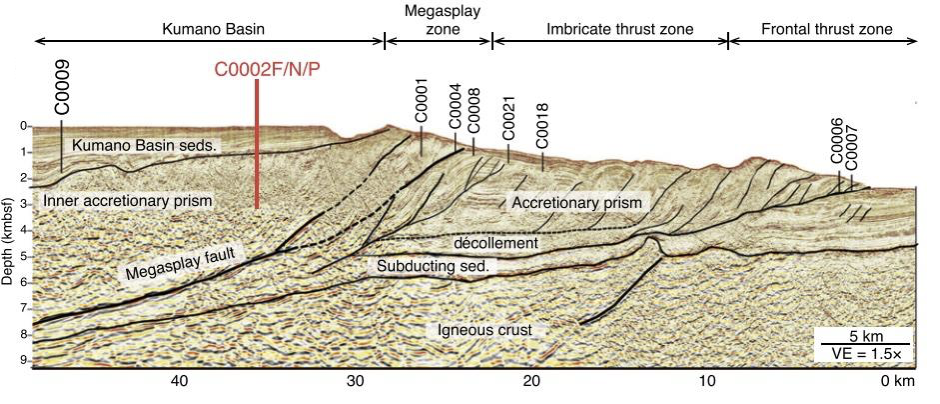Scientists drilled deep below the seafloor to see how stress builds within the Nankai megathrust, a major subduction zone off Japan’s southeast coast.
By Jay Barber, Science Writer (@JayBarber77)
Citation: Barber, J., 2022, Miles below the seafloor, scientists gather data on subduction stress, Temblor, http://doi.org/10.32858/temblor.287
Earthquakes can cause catastrophic damage and loss of life. Yet, no one can predict them. Earthquakes in subduction zones under the ocean pose a particular scourge. In this setting, two tectonic plates meet, with the less-buoyant plate diving below the other. When the plates get stuck, stress builds. Eventually, the locked plates must release the stress. If the release is abrupt, the result can be a megathrust earthquake, and the sudden movement can displace water, causing a tsunami.
Scientists who study subduction zones have long thought that if stress could be measured where the plates meet, the data could help them better forecast such events. However, because much of any given subduction zone dwells miles below Earth’s surface (which likely sits beneath miles of ocean water), physical measurements have been impossible — until now.
In recent research published in Geology, scientists drilled nearly 2 miles (3,058 meters) below the seafloor, toward the megathrust fault in Japan’s Nankai Subduction Zone. The data they collected show, rather unexpectedly, that tectonic stress does not seem to build up where scientists expected to find it.

Drilling for data
Harold Tobin, a seismologist at the University of Washington and Director of the Pacific Northwest Seismic Network, and his colleagues had hoped to drill all the way to the boundary where the Philippine Sea Plate subducts below the Amurian Plate in the Nankai Subduction Zone. But when they got down there, they found they couldn’t drill quite so deep. “It turns out that the place where the fault was accessible is in 2,000 meters (6,600 feet) of water and then 5 more kilometers (3 miles) below the bottom of the ocean,” Tobin says. For researchers to access the fault, they would need to drill 7 kilometers (4.3 miles) below the ship, which was floating off the southeastern coast of Japan. Thus far, they’ve drilled about 1.6 kilometers (1 mile) short of the fault. Nonetheless, the subduction zone is revealing some surprises.
Prior to this study, scientists hypothesized that the horizontal stress — the stress caused by the pressure of the tectonic plates pushing together — would be greater than the vertical stress caused by the weight of the rock at this depth. If true, then stress measurements could help scientists directly assess stress that’s built up from plate motion.
Because the last major earthquake in the Nankai Subduction Zone struck nearly 80 years ago (1944), Tobin and his colleagues expected to measure substantial stress accumulation. In other words, stress should have built up since that last earthquake, based in part on how the plates have since moved toward one another, which scientists know from other measurements, like GPS. But the team’s measurements did not show the level of stress they were expecting; measurements showed far less. “This finding was counter to our [expectation] of what we thought [the stress] would look like,” Tobin says.

One piece of the puzzle
Though researchers observed less stress than they expected, their findings don’t mean that the fault isn’t building toward a major earthquake. In fact, they suspect that if they could drill further down and get closer to the fault, or if they could extend the duration over which they collected their measurements, they might find what they originally expected. “We know that the plates really are converging. It’s definitely a subduction zone,” Tobin says. “Either the stress is changing in that next few thousand meters [closer to the fault], and it’s changing really rapidly, or it’s going to change over time [in the future].”
“It seems very likely that the stress near a major subduction fault should be pushing the fault in the direction of motion,” says Emily Brodsky, an earthquake physicist at the University of California, Santa Cruz, who has studied the workings of megathrust zones. “Oddly, this data shows that it is not.” The fault could still be early in its cycle, she says, which agrees with Tobin’s possible explanations. “It is a head-scratcher,” she says.
This research marks the first time seismic data have been collected so near to the subduction zone plate interface. “We [historically] make all of our observations with seismometers and GPS instruments here on the surface of the Earth,” explains Tobin. Yet, because earthquakes nucleate deep below the Earth’s surface, “we need observations down near the fault zones,” he says. “It’s like looking at Mars through a telescope versus sending a rover up to Mars.”
Because of this difference between where earthquakes begin versus where scientists collect data, much of researchers’ current understanding of earthquakes relies on models of how they think Earth breaks. These new data will allow them to update those models, says Tobin. “This is one piece in the giant puzzle of how earthquakes work.”
Ideally instruments could be placed into the drilled hole that would allow for long-term monitoring of stress buildup, says Tobin. The eventual goal of this work would be to use data from those instruments to understand whether precursory signs or activity exist prior to an earthquake that researchers can monitor. Should some measurable stress signal occur before a quake, then scientists could better forecast major seismic activity.
References
Tobin, H. J., Saffer, D. M., Castillo, D. A., & Hirose, T. (2022). Direct constraints on in situ stress state from deep drilling into the Nankai subduction zone, Japan. Geology, 50(11), 1229-1233.
- Earthquake science illuminates landslide behavior - June 13, 2025
- Destruction and Transformation: Lessons learned from the 2015 Gorkha, Nepal, earthquake - April 25, 2025
- Knock, knock, knocking on your door – the Julian earthquake in southern California issues reminder to be prepared - April 24, 2025
